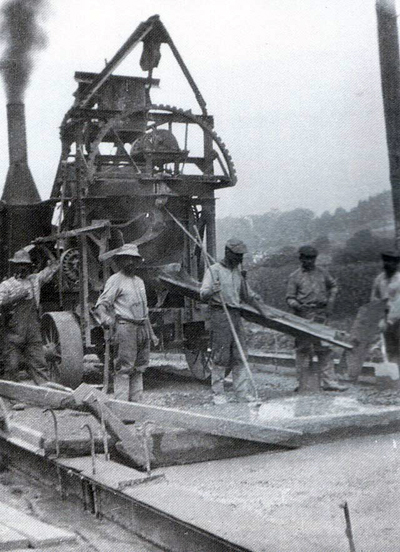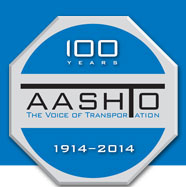
December 17, 1914
One Hundred Years Ago Today in Transportation...
 A brick road being laid in 1914 in rural New York State
A brick road being laid in 1914 in rural New York StateThe final month of 1914 proved to be a busy and productive one for state highway officials and good-roads advocates throughout the nation. The American Association of State Highway Officials (AASHO) was formally established on Saturday, December 12, in Washington, D.C., for example, and by that following Thursday, December 17, Chicago had become very much a beehive of good-roads activity.
The Windy City, starting on Monday of that week, was hosting three major roads events in the International Amphitheater in the Stock Yards: the 11th Annual Convention of the American Road Builders Association (ARBA); the Fifth American Good Roads Congress; and the Sixth Good Roads Show. This gathering was clearly seen far and wide as a huge deal. The Clay-Worker trade journal reported that “it is expected that this will be the greatest good roads occasion that ever happened.”
Sure enough, thousands were in attendance at the International Amphitheater that week. They came from just about every state as well as various foreign countries. There were all kinds of individuals connected one way or another with road work – including officials at the state, county, city, and town levels; contractors; and machinery and materials manufacturers and dealers. There were delegates attending on behalf of approximately 800 organizations, and governors of at least 25 states were represented.
As with the recent AASHO organizational meeting, one key issue for that gathering in Chicago involved the matter of federal funding for roads construction. As the Iowa-based Bayard Advocate newspaper mentioned in its on article announcing the events in Chicago, “National aid will be one of the subjects to receive particular attention.”
To a large extent, however, technical rather than legislative priorities more broadly and conspicuously defined the scope and excitement of that “good roads occasion” in Chicago. The Good Roads Show alone more than illustrated that point. There were roadwork displays and demonstrations, including motion pictures, among more than 100 exhibitors strategically stationed within the amphitheater.
One especially imposing exhibit was a paved road -- measuring 20 feet in width and almost 500 feet in length -- that had been put in place inside the building. Various segments of that model road had been built using materials and methods that were different from any other segment there. The road, which was characterized by the Indiana-based New Castle Courier newspaper as “a modern boulevard,” also featured trees and signposts set up along that route to give the whole exhibit a more authentic, outdoors look. There were also lamp posts installed at intervals along that route.
It was perhaps the technical sessions of the ARBA convention on December 17, however, that most fully mirrored both the overall enthusiasm for a better tomorrow for the nation’s roads and the expertise to make that tomorrow a reality. As the Municipal Journal announced in advance of the convention, “The various subjects to be treated have been so chosen to cover the important phases of the three divisions of the subject of highway work – organization, construction and maintenance.”
This emphasis could be very much seen on that Thursday morning in the presentation given by John Laylin, an engineer for the Ohio State Highway Department, who promoted the benefits of brick-paved roads in effectively accommodating ever-increasing traffic. “The road problem for heavy traffic roads has been solved in Ohio, according to Engineer John Laylin,” reported the Arizona Sentinel newspaper in its article on his talk. Laylin highlighted the work that had been done in Cuyahoga County, Ohio, and how the state highway department helped pave 225 miles of roadway with brick in that region over the past three years.
That afternoon’s proceedings included the presentation of a paper by Arthur R. Hirst, highway engineer for the Wisconsin State Highway Department, on extensive work being done in his state on concrete roads. Hirst (who would become AASHO’s fourth president in 1918) talked about the progress made with that project and how approximately 50 miles of concrete routes had been paved in the Badger State over the past three years. In that sense, Hirst very much reflected the triumphant theme of Laylin’s own presentation that morning.
Hirst, however, also emphasized the words of a colleague earlier that afternoon who told the attendees that they should not only discuss the successes but also the setbacks of road-building efforts. He then proceeded to do just that, telling his audience about the mistakes made in Wisconsin. “As a matter of fact,” he said, “we built in Milwaukee County six miles of concrete the first year, a portion of which was almost a complete failure, due to the fact that we used dirty gravel.”
The three-pronged good-roads extravaganza in Chicago came to an end the following day. As ARBA reported in its own subsequent summary of those events, “The registration was the largest of any road convention of which there is a record and included by far the largest number of actual road builders ever gathered together at any convention in this or any country.”












